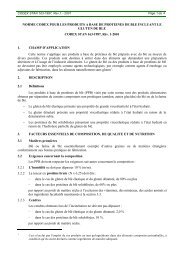issues and constraints related to the development of cashew nuts ...
issues and constraints related to the development of cashew nuts ...
issues and constraints related to the development of cashew nuts ...
Create successful ePaper yourself
Turn your PDF publications into a flip-book with our unique Google optimized e-Paper software.
11In addition <strong>to</strong> <strong>the</strong> direct impact <strong>of</strong> fires on farms <strong>and</strong> estates, with or without <strong>cashew</strong>, <strong>the</strong>re is anenormous environmental cost <strong>to</strong> <strong>the</strong> bush fires that rage across large areas, whe<strong>the</strong>r it is farm l<strong>and</strong>or not. Not only are crops, trees <strong>and</strong> grasses destroyed, but <strong>the</strong> valuable <strong>to</strong>psoil can also beeroded, leaving less <strong>and</strong> less fertile l<strong>and</strong>. Annual bush fires contribute <strong>to</strong> a decline in biodiversity<strong>and</strong> biomass, release a considerable amount <strong>of</strong> CO 2 <strong>to</strong> <strong>the</strong> atmosphere, <strong>and</strong> so contribute <strong>to</strong> globalwarming. Various human activities, such as <strong>the</strong> burning <strong>of</strong> fossil fuels, deforestation, grassl<strong>and</strong>conversion <strong>and</strong> o<strong>the</strong>r l<strong>and</strong> use changes, have contributed <strong>to</strong> large increases in <strong>the</strong> level <strong>of</strong> carbondioxide <strong>and</strong> o<strong>the</strong>r greenhouse gases in <strong>the</strong> atmosphere, which are thought <strong>to</strong> be responsible forglobal warming. Most experts now agree that if this trend <strong>of</strong> global warming continues, <strong>the</strong>global consequences could well be substantial <strong>and</strong> worst affected could be Africa.Overcrowding <strong>of</strong> treesCashew trees were over-crowded on many <strong>of</strong> <strong>the</strong> farms visited. Spacing was sometimes down <strong>to</strong>as little as three meters. The reason for such close spacing <strong>of</strong> trees was connected with <strong>the</strong>planting <strong>of</strong> <strong>cashew</strong> as a forestry crop for environmental purposes. Even when farmers planted<strong>cashew</strong> for commercial reasons, <strong>the</strong>y still planted at high density because <strong>the</strong>y didn’t know moreabout optimum planting distances for nut production.An interesting example was from a farm in Seguela district, Cote d’Ivoire. The farm was 3.75 hain size <strong>and</strong> was planted closely spaced over <strong>the</strong> years 1987, 1988 <strong>and</strong> 1989. The plot started <strong>to</strong>yield after 3 years <strong>and</strong> in 2000 it produced 3 <strong>to</strong>ns from 3.75ha, in spite <strong>of</strong> <strong>the</strong> fact that <strong>the</strong> treeswere over-crowded.Because <strong>the</strong> canopy was contiguous <strong>the</strong>re were no weeds. The farmer only had <strong>to</strong> control <strong>the</strong>weeds around <strong>the</strong> periphery <strong>of</strong> <strong>the</strong> plot where fire from outside was still a problem. With firebeing such a problem in <strong>cashew</strong> orchards (due <strong>to</strong> <strong>the</strong> presence <strong>of</strong> weeds), <strong>and</strong> labour <strong>to</strong> control<strong>the</strong> weeds being ei<strong>the</strong>r in short supply or expensive, it might be more economic <strong>to</strong> plant <strong>cashew</strong> athigh density. This keeps <strong>the</strong> weeds down, reduces <strong>the</strong> risk <strong>of</strong> fire damage <strong>and</strong> minimises labourcosts, although on <strong>the</strong> negative side, yields are lower. This might be acceptable if <strong>the</strong> followingconditions apply:- l<strong>and</strong> is plentiful,- labour is limited <strong>and</strong>/or expensive- diseases are <strong>of</strong> little importance (high density planting <strong>of</strong>ten exacerbates diseaseproblems)- insect pest problems are not made worse by high-density <strong>cashew</strong> trees.- fire is <strong>of</strong>ten a problem.A number <strong>of</strong> farmers commented that <strong>the</strong>y preferred a dense <strong>cashew</strong> st<strong>and</strong>, in order <strong>to</strong> not have <strong>to</strong>weed. When more quantitative data is available, a rigorous economic analysis should be done onhigh versus normal density planting. It is also extremely important <strong>to</strong> bear in mind that a densecanopy makes it very difficult <strong>to</strong> achieve good overall coverage <strong>of</strong> each tree with insecticide orfungicide, should application <strong>of</strong> <strong>the</strong>se be required.Conclusions regarding environmental <strong>constraints</strong>The problem <strong>of</strong> flowers drying out resulting in no production is sufficiently serious <strong>and</strong>widespread <strong>to</strong> warrant immediate research. Progress on this <strong>to</strong>pic could be made relativelyquickly, at least <strong>to</strong> <strong>the</strong> point <strong>of</strong> narrowing down <strong>the</strong> number <strong>of</strong> fac<strong>to</strong>rs that might be responsible.


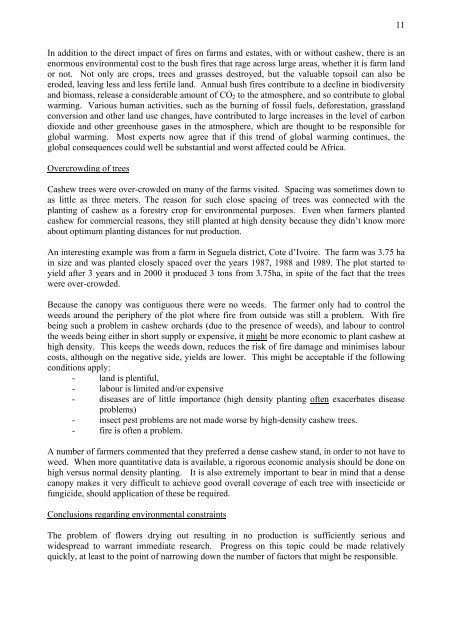
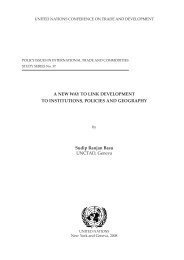



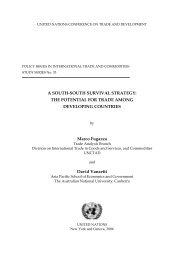

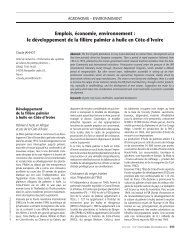



![Warehouse Receipt Systems: Legal Issues [PDF]](https://img.yumpu.com/43979338/1/190x134/warehouse-receipt-systems-legal-issues-pdf.jpg?quality=85)
